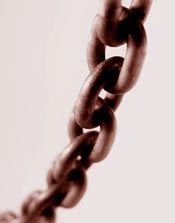Protection racket generates drug leads

Cutting chemical links one at a time simplifies molecule making <br>© Photodisc <br>
Chemists build molecules by paring them down
Complex molecules, such as many drugs, can be fiddly to assemble. By binding their starting compounds in chains1, chemists in Denmark may have found a way speed the automated chemical synthesis of such complicated products.
Les Miranda and Morten Meldal of Carlsberg University in Copenhagen have solved the following problem. Complex molecules are usually built up from a core with several near-identical hooks on which chemists hang different chemical units. Adding the reagents needed for any one of these additions usually attaches units randomly to any available sites.
Chemists normally get round this in much the same way that artists lay down different colours in screen printing — they mask all the sites bar the one they want to modify. After transforming the exposed site, they remove all the protecting units and repeat the process for the next site using a different shaped protecting group.
It is a painstaking task, each protection and deprotection step can waste a little of their precious molecule. Unfortunately chemistry is too indiscriminate to do without protecting groups.
Miranda and Meldal suggest an alternative: ’unichemo’ protection. This doesn’t eliminate protecting groups, but it greatly simplifies their use. The researchers use essentially the same protecting group for all the different sites, so that the same chemical reactions can attach and detach the groups. But they expose just one site at a time for modification.
The protecting groups aren’t all removed from the core molecule at the same time because they are different lengths. They are oligomers – short chains of identical links. These are attached simultaneously, and then whittled away one link at a time.
Sites protected by a one-link oligomer are the first to be stripped naked, whereas those with longer chains attached remain protected. A further round of link removal exposes sites capped with two-link oligomers, and so on.
The duo demonstrates their approach by modifying a short peptide — a protein-like molecule. The peptide has five almost identical sites to which the researchers affix modifying groups. They protected these sites with oligomers of one, two, three, four and five links.
Using reactions that attack only the dangling end of the chains, the researchers cut away the protecting groups one link at a time and stuck a different molecule onto each of the peptide’s five sites. This task would be “an extraordinary challenge for conventional protection strategies”, the chemists say.
The unichemo scheme should be particularly suited to the kind of automated chemical synthesis increasingly used to create libraries of candidate drugs.
References
- Miranda, L. P. & Meldal, M. Unichemo protection: a concept for chemical synthesis. Angewandte Chemie International Edition 40, 3655–3657 (2001).
Media Contact
All latest news from the category: Life Sciences and Chemistry
Articles and reports from the Life Sciences and chemistry area deal with applied and basic research into modern biology, chemistry and human medicine.
Valuable information can be found on a range of life sciences fields including bacteriology, biochemistry, bionics, bioinformatics, biophysics, biotechnology, genetics, geobotany, human biology, marine biology, microbiology, molecular biology, cellular biology, zoology, bioinorganic chemistry, microchemistry and environmental chemistry.
Newest articles
Faster, more energy-efficient way to manufacture an industrially important chemical
Zirconium combined with silicon nitride enhances the conversion of propane — present in natural gas — needed to create in-demand plastic, polypropylene. Polypropylene is a common type of plastic found…

Energy planning in Ghana as a role model for the world
Improving the resilience of energy systems in the Global South. What criteria should we use to better plan for resilient energy systems? How do socio-economic, technical and climate change related…

Artificial blood vessels could improve heart bypass outcomes
Artificial blood vessels could improve heart bypass outcomes. 3D-printed blood vessels, which closely mimic the properties of human veins, could transform the treatment of cardiovascular diseases. Strong, flexible, gel-like tubes…




















